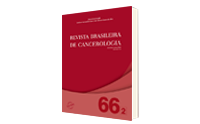Nutritional and Functional Evaluation in Oncology and Clinical Outcome in Patients in the City of Caxias do Sul/RS
DOI:
https://doi.org/10.32635/2176-9745.RBC.2020v66n2.996Keywords:
Neoplasms/drug therapy, Nutritional Status, Malnutrition, Muscle Strength DynamometerAbstract
Introduction: Malnutrition is frequent in cancer patients, impairing functionality and increasing mortality. Objective: Perform nutritional and functional assessment of patients undergoing chemotherapy and, after 6 months, evaluate the clinical outcome. Method: Observational epidemiological study, with longitudinal design, derived from a cohort followed for 6 months, formed by cancer patients undergoing chemotherapy treatment. Nutritional assessment was performed using the Body Mass Index (malnutrition; eutrophy; overweight; obesity) and the Patient-Generated Subjective Global Assessment (well nourished; moderate malnutrition or suspected malnutrition; severe malnutrition). Functional assessment was performed using manual dynamometry (adequate muscle strength; muscle weakness). The chi-square test was used to compare categorical variables and Poisson regression to identify the prevalence ratios and 95% confidence intervals. Results: Of the 208 investigated, 55.3% were elderly. There was a significant difference in the results of the nutritional assessment methods (p≤0.0001). Also, most patients with muscle weakness were not malnourished (p=0.013; p≤0.001). After 6 months, 68.4% of deaths were in malnourished patients (p≤0.0001). Advanced age (p=0.018; p=0.010) and muscle weakness (p=0.039; p=0.002) were associated with malnutrition. Conclusion: Most patients were not malnourished, although most of them had reduced functional capacity. Nutritional assessment methods differed from each other. After 6 months, patients who died had 2 times more chance of malnutrition.









